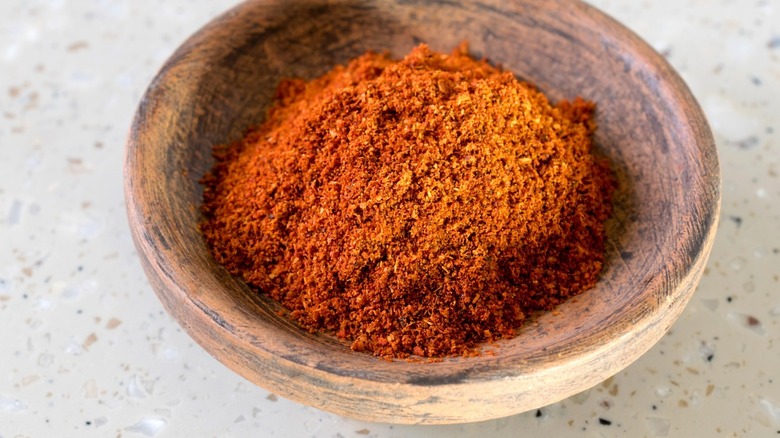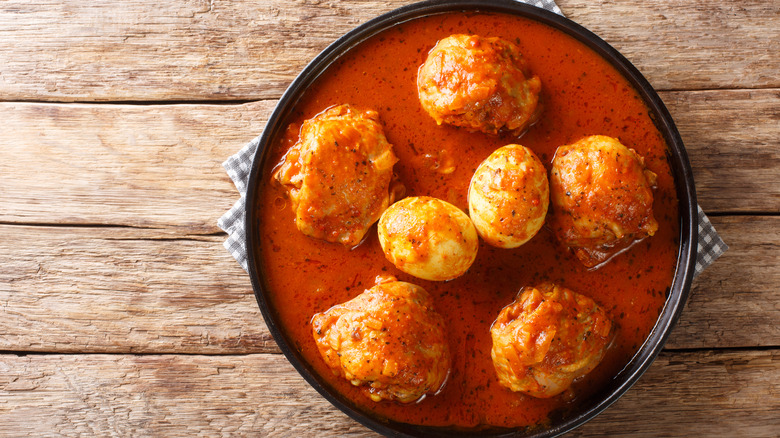What Is Berbere And How To Use It?
Many cuisines from around the world have unique spice blends: garam masala, jerk spice, adobo. And then there's berbere. This dark, burnt red-colored powder is made of a mix of toasted and ground spices that pack quite a bit of heat, and it features heavily in Ethiopian cuisine, per Food Network. According to the spice company McCormick, this spice blend is the most popular seasoning in Ethiopia.
While you can make an authentic berbere from pre-powdered spices (via Daring Gourmet), traditionally it's made by first toasting or drying hot and smoky-tasting Ethiopian Berbere peppers, though other chilies can be used (via Spice India, Specialty Produce). Recipes can vary, but most begin with pan-toasted coriander and fenugreek seeds combined with allspice, cardamom, cloves, and garlic. Dried onion and chiles are added. All of the ingredients are then ground together to make the berbere blend, according to chef Marcus Samuelsson's website.
Berbere can be used in either its powdered form as a rub, as a paste, or as a seasoning, per Demand Africa. As Demand Africa describes, berbere brings a warmth and earthiness to the meats and stews that it's often used in.
Berbere varies by chef and by region
While there are default ingredients you'll always find in berbere, each individual chef customizes it to suit their own taste and ingredients at hand, Demand Africa notes. Ethiopian-born celebrity chef Marcus Samuelsson concurs. He told Tasting Table, "There's a level of terroir to it in Ethiopia. Every family makes their own berbere and dries it in the sun, so if you have a lot of sun, it will come out one way, and if you add a lot of garlic, another." He also noted to Travel + Leisure that there's a regionality to the berbere. The taste, which can be hot, also has notes of citrus and sweetness, and will also vary depending on the climate is in the area where it's made. Even the native plants in the area will affect the overall flavor. "Spice is very much like wine. It reflects its terroir," he stated.
Like most home chefs, Samuelsson makes his own blend and uses it regularly. "Right now, if I could, I would lead you to the red tin in my kitchen, one of dozens I keep by the stove in my apartment in Harlem, filled with my own blend and marked with blue electrical tape and my own illegible scrawl. I would reach into this tin and grab a handful of the red-orange powder, and hold it up to your nose so you could smell the garlic, the ginger, the sun-dried chili," he wrote in Explore Parts Unknown.
How berbere is used
The cultural connections in Ethiopia to berbere are no more evident than when talking to celebrity chef Marcus Samuelsson. When his birth mother died of tuberculosis in 1972, he was only two years old. But though she died young, Samuelsson feels connected to her, and to his birth country of Ethiopia, through cooking. "I have never seen a picture of my mother, but I know how she cooked. For me, my mother is berbere, an Ethiopian spice mixture," he writes on Explore Parts Unknown. "You use it on everything ... It's our salt and pepper. I know she cooked with it because it's in the DNA of every Ethiopian mother." Samuelsson also notes that berbere can be used with shiro — a chickpea flour that's spiced, simmered, and then spread on injera bread.
According to the Ethiopian Embassy, Addis Ababa-baed chef Yohanis Hailemariam featured berbere prominently in his debut cookbook "Ethiopia: Recipes and Traditions from the Horn of Africa," including recipes for Doro Wat, a chicken stew, which Daring Gourmet notes is one of Ethiopia's most popular dishes. In addition to wats, according to The Kitchn, berbere can bring a kick to burgers, greens, roasted veggies, lentils, and meatballs.


